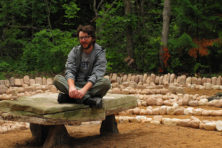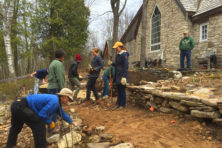Culture Club: Honoring Tradition at the Clearing
- Share
- Tweet
- Pin
- Share

by Mike Schneider, executive director of The Clearing
Although Jens Jensen died in 1951, and his longtime assistant, Mertha Fulkerson, died in 1971, their influence at The Clearing is still strong, as it should be. Institutions should honor their founders and follow the important traditions they established, no matter how long the founders have been gone. The Clearing would lose part of its soul if it were to let the memory of Jens Jensen and Mertha Fulkerson, and all they did to make this place possible, slip away.
Many of the traditions established in The Clearing’s early days, traditions that continue to this day, involve meals. Clearing students and instructors are still called to meals in the Lodge by the bell Jensen somehow managed to get from the original Ellison Bay School – now the Savory Spoon – when a new school opened across the street from The Clearing in 1925. The tables on which meals are served, tables built in the 1940s, are set with Blue Willow china. Platters and bowls of food are passed to the left. Family-style meals are hosted by a member of the staff. And the host reads an inspirational “thought for the day” before meals. Collectively, these meal traditions are fundamental to The Clearing experience for those who are here for a week-long class.
The importance of the meals notwithstanding – some guests claim that the meals are the main reason they come – it’s what’s outside at The Clearing that matters most. If love and respect for The Clearing’s outdoor environment – the woods and meadows, the path along the edge of the Niagara Escarpment, the view over water to the setting sun – qualifies as a tradition, then that’s the most important one at The Clearing. A love of native landscapes is what drew Jens Jensen to Door County in 1919, when he was searching for a family retreat – a place that would become his folk school in 1935. He is widely regarded as the father of the native plant and native landscape design movement in the Midwest. More than anyone, he helped forge a new path in landscape design, beginning in Chicago in the late 1800s, as a “maker of natural parks and gardens.” Jensen is one of the most important landscape architects in American history. He was referred to as the “Dean of American landscape architects” in his obituary in the New York Times.

We treat The Clearing’s land and landscape the way we think Jensen would have treated it. New trails or roads that have been built since Jensen’s time are the winding trails and roads for which Jensen is famous. (The road to Northport is a classic “Jensen road.”) All stonework at The Clearing – the free-standing walls, retaining walls, stone tumbles, flagstone walks, the ponds in the Quarry Garden – are built from Niagara dolomite, the stone that’s “native” to the area. The stone for many of these projects was gathered on the property, just as it was during Jensen’s time. And all landscape plantings are done using plants native to northern Door County.
We have another tradition here, one I call “The Clearing aesthetic.” It refers to certain design elements that are seen on and inside buildings. Our newer buildings, including the Jensen Center (1997), the Workshop (2007) and the Forge (2017), incorporate design elements that Jensen used for the Lodge (1942) and the Schoolhouse (1938). These include a steeply pitched roof, tall window at the gable end so “earth, water and sky can all be seen together” and, at the Jensen Center, like at the Schoolhouse, flying buttresses that support the weight of the roof, rather than having beams running across the building interior. And in the Workshop and Forge, we paid homage to Door County’s early settlers by including an interior stovewood wall, a common construction method in Door County’s pioneer days.
Many pieces of furniture in the Lodge, classroom buildings and lodging rooms, much of it built by Ellison Bay’s own Curt Wessel over the last 25 years, take their design cues from older furniture that was built during Jensen’s time, most notably the chevron-like triangle that is iconic at The Clearing. Like the furniture, many of the utilitarian items in our indoor spaces are handmade for The Clearing – quilts, throws, waste baskets, tissue baskets, forged metal hooks, brooms and dustpans, honoring what the Danes called “the work of the hand,” a tradition Jensen brought with him from his homeland.
Finally, our 2006 conservation easement with the Door County Land Trust honors another very important Clearing tradition: advocacy for land conservation. Jens Jensen did very important conservation work throughout his long career. In Door County, where he lived fulltime from 1935 until his death in 1951, he was part of the group that established The Ridges Sanctuary in 1937. He helped lay the early groundwork for Whitefish Dunes to become a state park 16 years after he died. And in the mid-1940s, when he was in his mid-80s, Jens Jensen played the key role in establishing Ellison Bluff and Door Bluff Headlands County Parks. So, taking the long view, protecting 94% of The Clearing’s property from development “in perpetuity” might just make our conservation easement our most important tradition.


